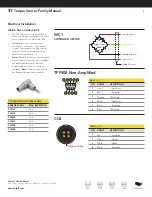
TFF Torque Sensor Family Manual
10
Sensor Solution Source
Load · Torque · Pressure · Multi-Axis · Calibration · Instruments · Software
www.futek.com
Troubleshooting
When troubleshooting, we recommend that the sensor be removed from any fixtures . In order to confirm that that sensor
is operating correctly, we suggest placing the sensor on a firm surface, and to apply a known load .
We also recommend using a volt meter with a clean power supply to confirm the sensor is operating correctly .
SYMPTOM
POSSIBLE CAUSE
CHECK
REPAIRABILITY
High zero output
• Sensor is under preload
• Sensor has been overloaded from too
much load, off axis load, or moment .
• Fixtures or bolting stress for causes of
pre-load .
• Loading and support placement for off
axis loads .
• Avoid excessive moments during
installation .
• Overload shift would not be repairable .
• If zero offset is stable it may be
possible to use sensor by use of Tare
or subtracting zero from sequential
readings .
Non-responsive
zero output
• Sensor or instrument is not powered .
• Sensor is not properly connected .
• Load is not displaced properly onto
sensor .
• Sensor is not supported correctly and
not allowing deflection to occur to
measure load .
• Internal disconnect or short .
• Power and wiring to sensor and instru-
ment .
• Sensor bridge resistance for possible
opens or shorts .
• Perform continuity test on cable .
• Load is placed correctly on sensor
loading surface .
• Sensor loading surface is not obstruct-
ed or supported and able to flex under
load .
• Sensor support is not giving while
sensor is loaded .
• Internal disconnections or shorts would
not be available for repair .
• Sensor cable repair may be available
if disconnect or short is not too close
to sensor .
Non-responsive
high output
• Sensor is disconnected from
instrument .
• An opening has occurred in sensor or
cable connection .
• Sensor has been overloaded and de-
formed causing permanent high stress
on internal gauges .
• Fixture, applied load, or mounting is
causing a high pre-load on sensor .
• Power and wiring to sensor and instru-
ment .
• Sensor bridge resistance for possible
opens or shorts .
• Perform continuity check on cable .
• Sensor zero output to see if sensor
returns to zero or has a high zero load
output due to overloading .
• Remove load and loosen mounting
bolts or fixtures to check if sensor is
being preloaded .
• Overload shift would not be repairable .
• Internal disconnections or shorts would
not be available for repair .
• Sensor cable repair may be available
if disconnect or short is not too close
to sensor .
Incorrect output for
applied load
• Load is not applied correctly to sensor
loading surface or is off axis .
• Fixtures are not secure or obstruct
loading .
• Sensor loading surface is not able to
deflect with applied load .
• Sensor support is not ridged and firm .
• Incorrect sensor output is utilized .
• Placement of load on sensor .
• Fixtures are not impeding ability to
load .
• Support surface is not giving with
applied load .
• Calibration verified outputs are being
used .
• Recalibration is available for confirma-
tion of sensor performance .












